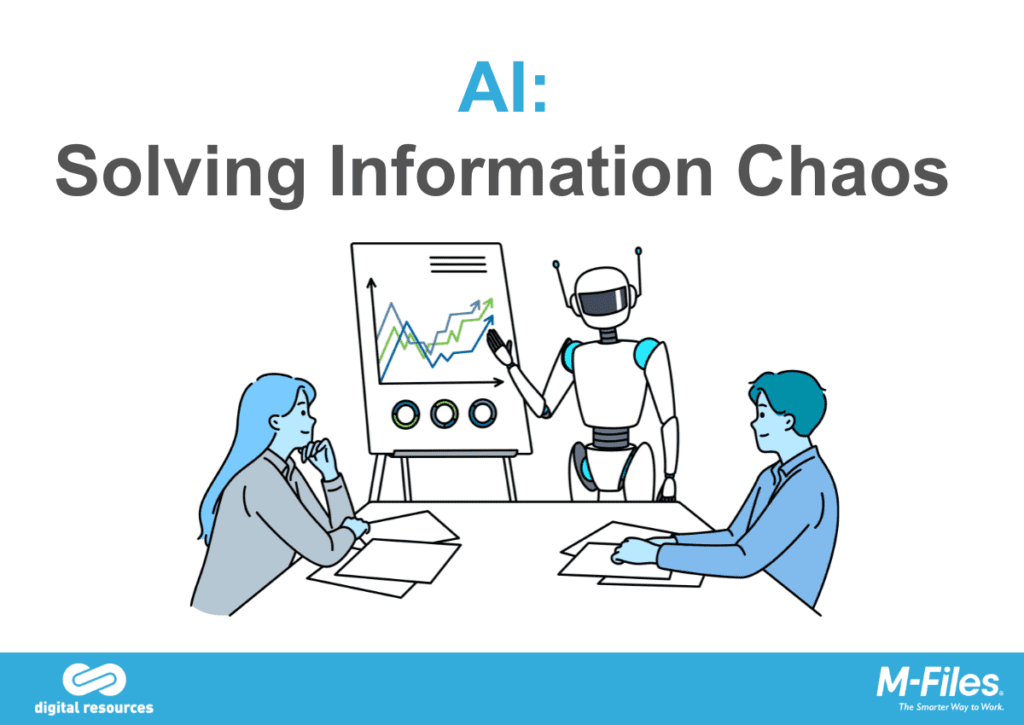Since the emergence of artificial intelligence (AI), organizations have been trying to harness the power of this new technology. When used correctly, AI can be a powerful tool for solving information chaos and transforming business processes. This enables organizations to achieve greater efficiency, innovation, and growth in a dynamic business environment.
At Digital Resources, we use the latest technologies. As one of the TOP 5 global partners of M-Files, we help organizations daily to efficiently search, manage, and organize documents using advanced artificial intelligence.
How to solve information chaos?

AI as a Solution:
In today’s digital era, organizations face the challenge of “information chaos“, struggling to efficiently manage, analyze, and utilize vast amounts of data. Artificial Intelligence (AI) provides a solution to this issue.
One of AI’s greatest advantages in business systems is its ability to automatically classify documents and data, ensuring better accessibility while reducing the risk of human errors. According to an M-Files survey, up to 85% of workers could make their jobs easier by using AI, as they could quickly and easily find the most up-to-date documents and information. This would lead to increased productivity for the company and the elimination of many hours of manual work.
However, the accuracy of these processes depends on the quality of the available data. If data is not properly classified and processed, AI may struggle to distinguish between a low-quality draft and a carefully crafted expert document.
How to Successfully Implement Generative AI?
1. Develop a Clear Strategy
- Align AI integration with the company’s overall goals.
- Involve key stakeholders from different departments to ensure the strategy meets diverse needs and fosters a sense of ownership.
2. Establish Data Management Processes
- Implement automated processes for data storage, organization, classification, and access control to maintain consistency and compliance.
- Assess the relevance of data for AI processing while considering legal and ethical aspects.
3. Evaluate IT Infrastructure
- Ensure systems and integrations support content strategy and data governance requirements.
- Assess generative AI solutions based on vendor reliability, pricing models, and overall cost-benefit analysis.
4. Expand Automation of Content Processes
- Identify opportunities for advanced automation to enhance decision-making and provide real-time insights.
- Reassess existing processes to transform workflows and value creation.
5. Assess Content for End Users
- Consider the different needs of user groups and ensure AI enhances their workflows.
- Invest in training, establish AI ambassadors across departments, and develop a communication strategy to foster enthusiasm and address concerns about AI adoption.
An example of such a solution is M-Files, which can be enhanced with the AI-powered assistant Aino. Its key advantage is the ability to summarize document content regardless of language and subsequently translate it. Additionally, Aino can search for precise answers within documents and automatically store summaries or key information as metadata in M-Files, significantly improving search capabilities. M-Files Aino thus takes business productivity to the next level.
AI is a technological change that is redefining the way organizations work with information. The key to success is not only the deployment of AI tools, but also a strategic approach to their implementation. Businesses that invest in AI can expect faster innovation, more efficiency, and better decision-making processes.
Source: M-Files. (n.d.). Solving Information Chaos with AI. Retrieved from https://www.m-files.com/blog/articles/solving-information-chaos-with-ai/
